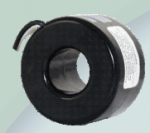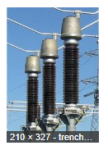You are using an out of date browser. It may not display this or other websites correctly.
You should upgrade or use an alternative browser.
You should upgrade or use an alternative browser.
CT, VT, CBCT , Power Transformer and Polarizing transformer
- Thread starter Szia
- Start date
- Status
- Not open for further replies.
mbrooke
Batteries Included
- Location
- United States
- Occupation
- Technician
Dear All,
Please explain to me these types of transformer<
CT= current transformer. Used for measuring current through a conductor.
VT= voltage transformer. Used for measuring the voltage at a certain point in the system
power transfomer: used to supply power or move bulk power. ie, 115 to 12.47kv 50MVA transformer or a 13.8kv to 277/480Y. Technically any transformer thats not for protection purposes and used to supply electricity for heat, light and power.
CBCT (core balance current transformers) - this is a type of CT that mbrooke mentioned in his post, however in a CBCT you put all three phase wires of a three phase system inside of the current transformer. This is mainly used for ground fault detection. If there are no ground faults in a three-phase system, then the summation of the three phase currents should be equal to zero. If there is a ground fault on the system, then that same summation does not equal zero, and therefore the CBCT shows a value, indicating there's a ground fault.
Pictures:
Current Transformer - you put the wire in which you're trying to measure current through that middle hole of the CT, and depending on the current going through the wire, you'll have a current flowing through the black and white wires on the upper left side. This is called the CTR, or Current Transformer Ratio. The one in this picture has a CT ratio of 100:5, meaning that if 100A of current is flowing through the wire that this is placed around, you'll see 5 amps of current flowing through the black and white wires.

Voltage Transformer - this picture shows a voltage transformer inside a substation. They work very similar to current transformers, it reads what the voltage of the line is and then steps it down to a safe voltage for the metering equipment.

Using a combination of voltage transformers and current transformers, you can calculate all sorts of things like watts, VAR's, VA's, power factor, etc. These also vital in the protection of large-scale electrical circuits.
Pictures:
Current Transformer - you put the wire in which you're trying to measure current through that middle hole of the CT, and depending on the current going through the wire, you'll have a current flowing through the black and white wires on the upper left side. This is called the CTR, or Current Transformer Ratio. The one in this picture has a CT ratio of 100:5, meaning that if 100A of current is flowing through the wire that this is placed around, you'll see 5 amps of current flowing through the black and white wires.

Voltage Transformer - this picture shows a voltage transformer inside a substation. They work very similar to current transformers, it reads what the voltage of the line is and then steps it down to a safe voltage for the metering equipment.

Using a combination of voltage transformers and current transformers, you can calculate all sorts of things like watts, VAR's, VA's, power factor, etc. These also vital in the protection of large-scale electrical circuits.
Last edited:
mbrooke
Batteries Included
- Location
- United States
- Occupation
- Technician
Using a combination of voltage transformers and current transformers, you can calculate all sorts of things like watts, VAR's, VA's, power factor, etc. These also vital in the protection of large-scale electrical circuits.
And apparent impedance, one of the most essential and common protection elements of HV transmission systems where voltage and current both work simultaneously. Ie, current is operate, voltage is restraint in simplified terms.
- Location
- San Francisco Bay Area, CA, USA
- Occupation
- Electrical Engineer
The CBCT tells you IF you have current flowing to ground, then using VTs in a special configuration as Polarizing Transformers you can determine which DIRECTION the current flowing to ground is going in respect to the protective relaying location.
- Status
- Not open for further replies.

